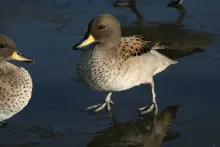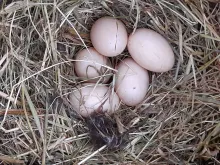
Yellow-billed teal (Anas flavirostris)
Species name
- Dutch name:
- Chilitaling of Gespikkelde taling
- English name:
- Chilean teal
- German name:
- Chile-Krickente
- French name:
- Sarcelle du Chili
- Scientific name:
- Anas flavirostris
Scientific classification
- Order:
- Anseriformes
- Family:
- Anatidae
- Onderfamilie:
- Anatinae
- Genus:
- Anas
Description
- Description:
Male:
Yellow-billed teal or Chilean teal vary in size, shape, and color, depending on age, sex and subspecies. Anas flavirostris is a relatively small duck. Its colors are more subdued. Yellow-billed teal or Chilean teal generally have dark colored spots on the neck and breasts that extend towards anterior regions of their bodies. They have tan to brown feathers with black tips. Bill coloration with these two subspecies is dark to light yellow.Female:
Are Smaller But look like the males But, less colorful. Bill Dull Yellow.Juvenile:
Less colored than males or females. But more diffuse spotting on the breast and flanks, extending short way onto the belly. Wing lacks much green on speculum. Bill dull yellow males get brighter before their first breeding season. Acquires adult plumage thru their first winter.Differences in appearance among subspecies are as follows: Anas flavirostris altipetens displays a grayish-brown, densely peppered head and neck. Hence, the name "speckled". The scapulars, which are the shoulders of the duck, are black with lighter colored edges. Anas flavirostris oxyptera has a much paler head relative to other subspecies, but similar speckle patterning. Bills of A. flavirostrisflavirostris and A. flavirostris oxyptera are mainly yellow.
- Behaviour:
The behaviors of speckled teals are similar to that of other teal species. Preening behind the wing occurs in both male and female birds. Pre-flight head shaking and jerking is performed, and they are known to be very fast fliers. In winter months, speckled teals are known to stay in breeding pairs but this behavior is thought to be for safety reasons and not for courtship purposes. Displays of greeting gestures occur anytime that both male and females are present. In captivity, these birds show little fear of humans and tend to do very well.
Communication is common between male and female speckled teals, but it typically takes the form of mating displays or rituals. Agnostic behavior occurs between males and is usually competitive, although these displays have multiple purposes. Generally, A. flavirostris is not territorial. Instead, if both males and females are present, displays may be used to ward off potential competition from other males and to attract potential mates.
Standard Measurements
- Body Length (cm):
- The male (drake) of the Yellow-billed teal measures approximately 35-45 centimeters. The female measures approximately 35-45 centimeters.
- Body Weight (grams):
- The male will weight about 600-830 gram. The female will weight about 565-795 gram.
The weight is notoriously variable and can only be used as indication!
- Subspecies:
There are two subspecies:
- Anas flavirostris flavirostris - Yellow-billed Teal, Speckled Teal or Chilean Teal - Nominate Race
- Anas flavirostris oxyptera - Sharp-winged Teal or Sharp winged Speckled Teal
- Note:
Dabbling Ducks are generally hardy, easy to maintain and easy to breed. Shelter may be required by some of the smaller species in winter. They should be provided with cover (including marginal pond cover) and loafing areas as well as water. A pen which is 50% water is suggested. The water may be shallow (i.e. no more than two feet deep is required), and muddy areas for dabbling in are also appreciated. These ducks are generally good in mixed collections, although the smaller and quieter species may be bullied. Territorial disputes between ducks of the same species may be avoided by keeping only one pair of each species in an enclosure, unless the area is very large. For a single pair of ducks a pen are of 50 to 100 square metres, depending on the size of duck, should be provided.
A diet based on wheat and pellets is suggested, with maintenance pellets changed to breeders pellets for the breeding season. Bread and greenfood are also appreciated. Grit should always be available, with soluble grit (e.g. oystershell grit) as a calcium source when breeding.
Most species are ground nesters and both close ground cover and ground level nest boxes should be provided. Hand-rearing is generally preferred, as these ducks are generally poor parents in captive conditions, particularly in enclosures shared with other waterfowl. These ducks are prone to hybridization, particularly with closely related species, which should be kept apart from one another.
Yellow-billed teal or Chilean teal are generally winter-hardy; they may be kept on ice-free water, or shelter should be provided. They are suitable for mixed collections with other small ducks. Easy to manage, these ducks are more active at night. Feed as other dabbling ducks: wheat, pellets, greenfood, bread.
Easy to breed, raised nest boxes should be provided as well as close cover and ground-level boxes. They may lay as early as end of March in UK, starting in May in central Europe. These ducks may lay second and even third clutch if eggs removed, will also brood reliably if left; drake assists with rearing. Ducklings are simple to rear.
Frequent hybridisation reported with Common teal (Anas crecca); also hybrids with other Anas species and with Wood duck (Aix sponsa).
- Breeding:
- The female Yellow-billed teal usually lays from 5-8 creamy to yellowish buff eggs and incubates them for 24-26 days.
- Artificial incubating:
The ideal relative humidity for incubating most waterfowl eggs is 55% (ground nesters) and 40% (cavity nesters). The temperature is usually 37.4°C. Set ventilation as recommended by the incubator manufacturer. Eggs must be turned, either automatically or by hand, a minimum of 4 times a day. As the duckling develops there is a loss of water from the egg and the air sac gets bigger. In normal development of an egg with a 24-26 days incubation, the air sac occupies about a third of it three days earlier. Cleanliness is vital and ideally eggs should be moved to a separate hatcher at this point, where the humidity should be increased to 65% and even higher once they have pipped internally.
- Bird banding:
- Recommended closed leg band ring size for the Yellow-billed teal is 9 mm.The leg band ring can only be applied on a young dabbling duck at around 11-12 days old.
- It doesn't matter what leg that you band, but it's good to have a consistent system. Suggested: Left leg = Female, Right leg = Male
- Rearingfeed:
-
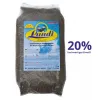
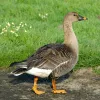

Floatable special rearing feed for all types of aquatic ornamental fowl - especially for the cultivation of trees as well as greening ducks.
This well-balanced complete feed with 20% protein content convinces above all by its good compatibility and forms the basis for visibly healthy growth from day one.
Made exclusively from wholesome and selected raw materials, Lundi Micro Regular is also ideally suited for the year-round feeding of waterfowl.
- Maintenance food:
-


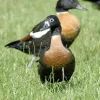


Floating full food for all sea ducks, green ducks, eider ducks and geese, especially in the moulting and breeding phase ideally suited. Packed with wholesome raw materials, natural vitamins and trace elements, this performance food with a protein content of 30% forms the basis for lifelong vitality.

